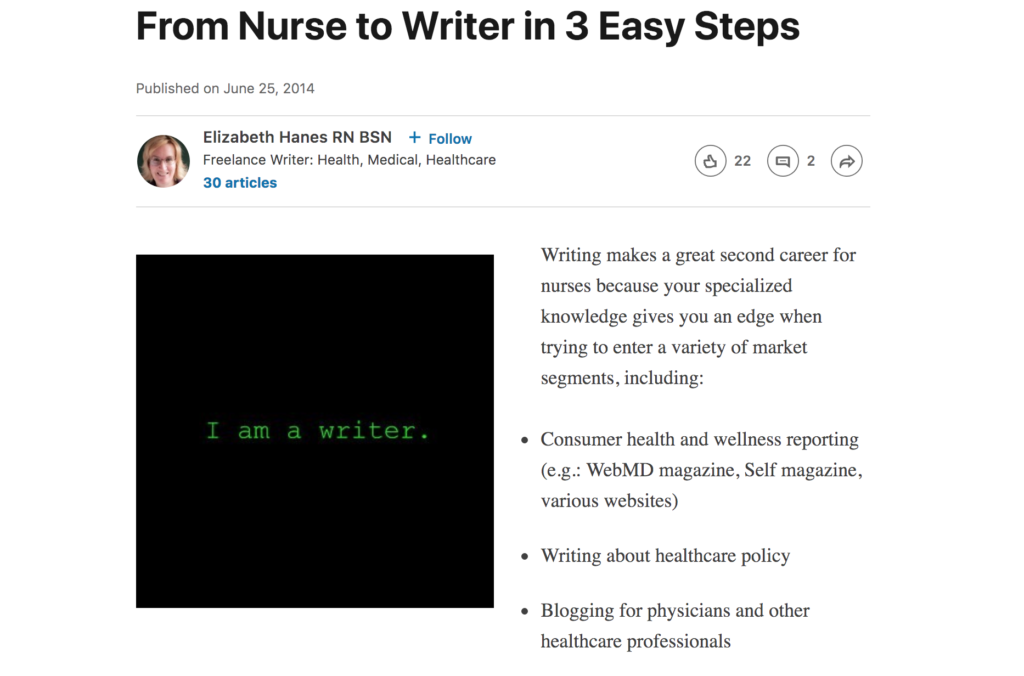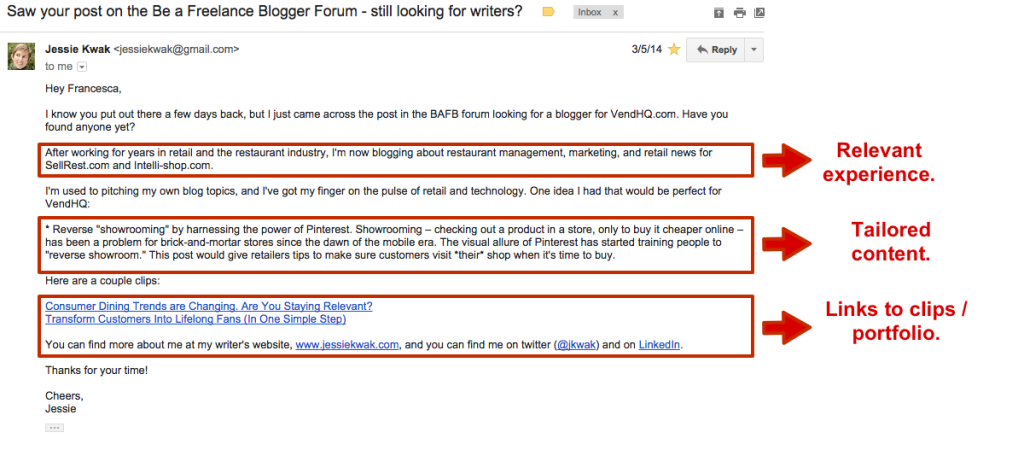 As a writing coach, I get questions about how to become a freelance writer on a regular basis.
As a writing coach, I get questions about how to become a freelance writer on a regular basis.
My responses to such questions typically vary, because the “right” answer depends on several factors including your industry, experience level, and the type of writing that you want to get into.
That said, there are some general best practices that apply to almost anyone who wants to get started freelance writing. I’ve shared these steps below, along with some tips and examples on how to implement them.
My goal is to give you some clarity and insights into what it takes to build a writing portfolio, find clients, and earn a living doing what you love.
Ready to get started? Dive in below or jump to a relevant section:
Step 2: Build your writing portfolio
Step 3: Find freelance writing prospects
Step 4: Send pitches to prospective clients
Step 5: Get freelance writing coaching or courses (if necessary)
Step 1: Find your niche
Finding your freelance writing niche simply means determining your position in the market. It answers the question “What do you specialize in as a freelance writer?”
Now, there’s always some debate between finding a specialty and being a generalist (i.e. someone who can write about “anything”). I stand securely in the “find a specialty” camp. While I’m sure there are writers who make a living writing about anything under the sun, I firmly believe that freelancers who focus on just a handful of topics or industries are in a better position to earn more.
Why? Because clients (particularly high-paying ones) prefer to work with experts and specialists. Think about it: let’s say you’re looking for a wedding photographer. Which vendor would you prefer: the photographer who focuses on weddings or the one who takes photos of couples, babies, animals, landscapes, buildings, and pretty much anything?
Chances are, you’d pick the former. And guess what? Companies that hire freelance writers would do the same thing.
Anastasia Sidko, the Content Manager at SEMrush, told me:
“Between two freelancers with equally good writing skills I’d choose the one who has experience in creating texts on the topic that I need. It is especially important when it comes to technical or very specific texts — deeper knowledge of the subject would be a significant advantage for the writer.”
Molly Berry, the Community Manager at Skyword, said something similar in our interview:
“Identifying your niche is really important. Some people think it might be advantageous to call themselves generalists or say ‘I can write about anything’ or ‘I can research anything,’ but in the content marketing industry, we’re not looking for generalists. We’re looking for people who have specializations.”
How do you determine your niche?
Ok, now that we’ve established the importance of finding your niche, let’s talk about how to find yours. There are a number of ways to do this. Here’s what I recommend:
a. Start with your interests – What are the topics or industries that you’re genuinely interested in? What are the things that you can write about all day? The answer to these questions could point you in the right direction.
For example, I know a writer who specializes in wine, and she spends her time writing for wine clubs and wine subscription services. (Cheers!)
b. Use your profession (or what you studied in school) – If you’re a student or if you’re working full-time, you can use your field knowledge to jump into freelance writing. Here’s a great example: Elizabeth Hanes is a freelance writer focusing on health, medical, and healthcare topics.
She started as a nurse and used her knowledge to find freelance writing gigs while having a day job.
Figure out if your niche is profitable
Not all niches are created equal. Before deciding on a topic or industry, you should first figure out if it’s profitable. How do you that? One word: research.
Dig around and answer the following questions:
How big is the industry? If people in a specific industry or market are spending a lot of money, that’s a good indicator that it’s profitable.
For example, let’s say you want to start writing about vitamins and supplements. A quick Google search for “how much is the vitamin industry worth” will give you the following result: “Dietary Supplements Market Size Worth $278.02 Billion By 2024”. I would take that as a sign that this is a big industry that has room for growth.
Are the companies in the industry thriving? Another sign of a great niche is if there are plenty of thriving companies operating in that space. Again, figuring this out requires research. Look into the businesses and see if they’re doing well. Are they making a lot of money? Do they have a lot of customers? If the answer is yes, then great!
Takeaway: Finding your niche is a critical step to becoming a freelance writer, so take the time to determine your specialty. Also, note that you don’t have to be married to a single niche. It’s possible to specialize in a handful of topics if that’s what you want. (I specialize in retail, ecommerce, SMB, technology, and freelancing).
The key is to identify those key topics and position yourself appropriately.
Step 2: Build your writing portfolio
While “How do I become a freelance writer?” is the most popular question I get, a close second is “How do I build my writing portfolio?”
And often, that’s followed by the phrase “…when I don’t have experience?”
Building a portfolio from scratch can be daunting, but it’s completely doable. I came up with a writing portfolio guide here, but below is a handy overview of the steps you need to take to create your portfolio:
Publish on LinkedIn
I’m a huge fan of LinkedIn. Aside from being a great tool for finding and attracting clients (more on this later), LinkedIn has a solid publishing platform that can help build your portfolio and promote your content.
Once you’ve selected a niche, cook up relevant article ideas then head over to LinkedIn and start publishing. For instance, my niche is retail, so I make it a point to write about retail-centric topics on the site. Here are a few articles I’ve published on LinkedIn:
- Visual Merchandising Quick Wins: 5 Retail Design Tips You Can Try Today
- What Exactly Do Consumers Want from Retailers? Check Out These 4 Trends
Publishing on LinkedIn is as simple as hitting the “Write an article” button on your homepage, then going from there.
Once you’ve published your post, take the URL and include it in your portfolio and email pitches.
Write guest posts
Another great way to get your first portfolio pieces? Publish guest posts. Find websites in your niche or industry, then get in touch to see if you can contribute a guest post.
I detail my step-by-step process for landing guest post opportunities in this post, but here’s a more condensed version of the process.
a. Identify websites to write for – You can do this by using tools such as Alltop and SimilarWeb. You can also run a Google search for “top blogs in [insert industry here] and see what comes up.
From there, make a list of websites that entertain guest contributors then proceed to the next steps…
b. Get to know the websites you want to approach – Once you have a list of potential websites to write for, spend some time browsing through each website. Read their posts, get to know their owners and editors, and engage with the community.
Put yourself on the radar of the each site’s owners and community members. Doing so will increase the chances of landing a successful pitch.
In addition, getting to know the websites you want to write for can help you generate the right article ideas. Reading a website’s existing content and interacting with their readers will help you identify potential topics and angles that would best resonate which each website.
c. Brainstorm topic ideas – Once you have a grasp of what each blog has to offer, it’s time to find potential topics to pitch to their editor/owner. This step should be fairly easy, especially if you took the time to get to know the site’s content and audience.
For best results, follow these tips when coming up with article ideas:
- Find a topic or angle that hasn’t been covered on the site
- Read through the comments section and take note of interesting questions or statements from readers
d. Pitch – It’s time to send in your guest post pitch. There are no one-size-fits all methods for guest post pitching because each site is different. That’s why it’s important to carefully read a blog’s or website’s contributor guidelines before reaching out.
Prior to sending your guest post proposal, familiarize yourself with the site’s contributor process. Take note of the following:
- How to contact the blog – Some websites prefer that you send them an email, while others have a contributor form.
- The pitch format – Is it ok to send a general article description or should you send a detailed outline? Do they allow contributors to submit fully-written articles? The “right” answer will vary, depending on the site.
- Post format – Do they want you to send a Word doc or Google doc? Should you include an image?
e. Write the post – Got a positive response to your guest post pitch? Great. Now you can proceed to actually writing the article. Again, follow each site’s content guidelines, particularly when it comes to post length, style, and format.Write the article, submit it to the site and wait for their feedback.
Once your post is accepted and published, give yourself a pat on the back — you now have an article to include in your portfolio!
Other ways to build your portfolio
LinkedIn publishing and guest posting are two of my favorite portfolio-building strategies, and I highly recommend them if you’re just starting out. That said, there are a handful of other ways to build your portfolio. You could also:
Write for free (at first) – Know anyone in your industry who needs content? Approach them and offer your writing services. Tell them that all you need in return is the right to use the content in your portfolio and (hopefully) a positive testimonial.
Publish on Medium – Medium.com is a popular publishing platform with an active community. Like LinkedIn, it gives you the opportunity to publish your posts and get in front of a wider audience.
Publish on your own blog – I’m honestly not a huge fan of using your personal blog to build a portfolio. Why? Because using your personal blog doesn’t exactly scream “professional writer”.
You can do it, sure, but that same piece of content would look more attractive if it were on an industry blog or a professional site like LinkedIn.
There are some exceptions though. If your website is directly related to the industry you want to break into — e.g. if your niche is personal finance, and you have a blog about saving money — then it’s fine to use that site’s content in your portfolio.
Also, if your website has a large and active community (and it’s relevant to your niche) then it’s totally ok to include it in your portfolio.
Step 3: Find freelance writing prospects
Once you’ve selected your niche and gotten yourself some sweet portfolio pieces, you should start actively searching and approaching potential clients.
The first thing you need to do at this stage is to come up with a list of potential clients. Pitching is a numbers game, so the more prospects you can reach out to, the better.
Note that by “prospects” I mean business people. High-paying freelance writing gigs are typically assigned by businesses looking to create advertising or marketing content — think blog posts, whitepaper, web copy, etc.)
Below are the steps you can take to find these prospects.
a. Identify industry directories
Identify key client sources in your niche — i.e. websites/places that would list the name and contact info of companies you can approach.
To do this, find industry-specific directories that you can mine for prospect information. For instance, when I first started out, I decided that I wanted to target tech companies. So, to build my prospect list, I used the website AngelList, a platform that lists the contact details and business info of tech startups.
I perused AngelList daily to find potential companies, got their contact information, and then I pitched my services.
Take a similar step when you’re trying to find clients. Think about specific websites or directories in your market/niche, then use them to build your list of potential clients.
b. Get creative — “directories” aren’t always labeled as such
Can’t find any good directories in your niche? Then you have to be a little creative. Ask yourself, what websites or sources would contain information about the businesses in your industry? Find those sources and mine them for leads.
Here are some ideas:
- Trade publications or websites – These sources usually have directories or business listings for companies in their industry
- Industry events – Get your hands on the list of companies sponsoring or exhibiting at a relevant event… and voilà — instant prospect list.
c. Use your network to find prospects
Do you know anyone who runs a business? Go through your personal and professional rolodex and see if there are people you can approach for gigs or referrals. At the very least, get in touch with key individuals in your network and let them know you’re looking for freelance writing clients.
Here’s a quick list to get you started:
- Former and existing co-workers
- Former classmates or professors
- Friends and relatives (particularly those who are entrepreneurial)
- Online contacts
- Businesses/services providers that you frequent (e.g. your accountant, that cafe owner down the street)
A note on finding quality prospects
Here’s a bonus tip for finding prospects: focus on companies that are willing and able to high rates for content. Your time is limited, so don’t waste it going after prospects that don’t have the budget for top-notch writers. Here’s a video I created a while back that offers tips on this very topic:
Step 4: Send pitches to prospective clients
Got your (hopefully long) list of prospects? Awesome. Now it’s time to get in touch and see if they need content writing services.
I wish I can give you a single “one size fits all” pitch template, but the fact is, the manner in which you approach prospects will vary, depending on the company and their needs.
There are, however, some general elements that can increase the success of your pitch. These include:
Finding the right person to reach out to
Avoid sending pitches to general email addresses. Try to find a specific person to approach. The right individual is typically someone in the marketing department (if it’s a large organization). Of if you’re approaching a small business, then you’ll want to reach out to the founder directly.
Tailoring your pitch
You need to incorporate some level of personalization into your pitch. And no, this isn’t just about including the prospect’s name in your message. Find creative ways to customize your message. You can, for instance:
- Mention how you found them (“I read about you on Forbes.com and was really impressed by your story.”)
- Talk about the specific value that you can provide (“I noticed that you don’t have a lot of content on your blog yet. I can help craft posts that can increase traffic to your site.”)
- Mention your relevant skills or experience (“I’ve spent years working as a [insert relevant job title] so I have a deep understanding of the [insert industry].”)
Relevant writing samples
Remember those guests posts and LinkedIn articles we talked about earlier? Include links to those articles in your pitch. Say something along the lines of…
Here are some writing samples to give you a better idea of my voice and style:
- Link to relevant sample 1
- Link to relevant sample 2
- Link to relevant sample 3
Answering the question “what’s in it for me?”
Too many freelancers make the mistake of crafting a pitch that is all about them, when it should be about the prospect. Remember, there’s only one question that’s running through someone’s head when they’re reading your message, and that’s what’s in it for me?
Make sure you answer that question in your pitch. What are the benefits that the client will get when they hire you? Here are some of the things I incorporated into my pitches:
- More website traffic (“Regularly publishing content can help you increase your search rankings and drive more visitors to your site.”)
- More leads (“I’d love to help you write guides and whitepapers to generate more leads for your business.”)
- Position the client as an authority or thought leader (“I can come up with thought leadership posts that position you as an authority in your industry.”)
- Free up time / resources (“I can take care of your content needs so you can spend more time on growing your business.”)
Sample pitches that landed gigs
Looking for examples of successful pitches? Check out the following:
Here’s an example from Jessie Kwak. It has all the key ingredients of an excellent pitch. She approached me directly, she included relevant experience, she provided great ideas and sent me links to her clips.
Here’s another one from yours truly. I came across a potential client as I was browsing press releases, and I noticed that their article had plenty of room for improvement. So, I decided to send a pitch talking about the specific benefits they’ll get by hiring me. I also included writing samples and personalized recommendations.
Recognize that it’s a numbers game
I’ve said before and I’ll say it again: the pitching process is a numbers game. Even the best pitches don’t get a response, and that’s not necessarily a reflection of the pitch itself. Often, getting a “no” (or not reciving a reponse) simply means that the prospect isn’t looking for a writer. Move on, and keep pitching.
Step 5: If you need more guidance on how to become a freelance writer, get help
Whew! We’ve covered a lot of ground, and I provided you with the key steps you need to take to become a freelance writer. You’re free to use everything in this guide to build your portfolio and client list, and I sincerely hope you land fabulous gigs because of this post.
That said, if you need additional help or even just a confidence boost, then take some time to hone your skills and get acquainted with the freelance writing industry.
It’s true that you’ll learn a lot about freelance writing by doing. You know — going out there, exploring your market, and trying to find clients. But your journey towards making it as a writer will be much easier if you know what you need to do.
That’s why I always recommend that you invest in resources that take the guesswork out of freelance writing. Learning from other writers will give you more confidence as you build your freelance writing business. You’ll know what works, what doesn’t, and you’ll get a roadmap that will help you minimize mistakes so you can get to where you need to be faster.
I myself read books, took courses, and paid for access to certain communities so I can learn the ins and outs of freelance writing. I’ve invested thousands of dollars in my freelance writing education, and I would do it again in a heartbeat.
And that brings us to the Freelance Writing Bootcamp.
This is a covers everything you need to know to become a thriving freelance writer — from getting those must-have portfolio pieces and finding clients to creating epic content that gets tons of traffic and shares.
It’s an insanely useful course for aspiring freelance writers, so if you’re looking level up your freelance writing game and start earning more, the Freelance Writing Bootcamp will help you hit the ground running. Specifically, you’ll learn:
- How to build an attractive writing portfolio… even if you don’t have any experience or existing writing samples
- Where to find high-paying clients, and what you need to do to attract them
- The exact steps and scripts that I use to approach clients and get them to purchase my services
- The strategies I use to land lucrative freelance writing gigs without turning to Upwork, Craigslist, and other job boards
- How I turned LinkedIn into a client magnet, and what I did to attract 300,000+ followers (and numerous client inquiries) on the site
- The processes I implement to keep clients happy and ensure consistent work
If you’ve been wanting to become a freelance writer, but you’re not sure where to start, this course is for you. It’s packed with videos, screencasts, handouts, templates and tools to help you jumpstart your freelance writing business.
Hope to see you inside, and here’s to your freelance writing success!






